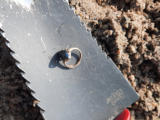

© 2025 Roger Fontaine, Designed by Bison Software

Metalman9
M
E
T
A
L
M
A
N
9


M
E
T
A
L
M
A
N
9


Ph: 204-223-7809
METALMAN9
Ph: 204-223-7809
METALMAN9
Click the date link, then a photo to start larger photo gallery & see descriptions

September 2, 2023 - Hot on the Trail
September 2, 2023
Hot on the Trail.
River
Lot
#
155
was
hot.
I
mean
really
really
hot…
35C
hot.
So
hot
in fact that I had to pack it in by about one in the afternoon. But what
a gorgeous morning sun.
Hello and welcome back to my website !
I
know
that
I
haven’t
posted
anything
since
June
24th.
Yes,
I’ve
been
out
metal
detecting
a
lot
this
summer
but
like
the
saying
goes,
“Make
hay
while
the
sun
shines”.
The
metal
detecting
season
can
be
short
in
this
country,
six
or
seven
months
at
best
and
then
at
times
in
spring
or
summer
it’s
too
wet
or
too
hot
to
go
out.
So…
This
year
the
weather
was
great
and
I
took
advantage
of
it
rather
than
sit
at
a
computer
but
I
will
now
have
a
great
stock
of
stories
and
pictures to post during those cold winter months.
I
finally
got
my
Minelab
Headphones
paired
with
my
Minelab
Equinox
800
metal
detector.
They
work
great.
Technology
and
I
generally
don’t
get
along
so
well
but
this
is
indeed
a
wireless
improvement.
Now
back
to
River
Lot
155
and
of
course
the
remnants
of
the
Pembina
Trail.
I’m
particularly
keen
on
this
river
lot
as
the
old
Pembina Trail forks into three as per the 1870 survey map.
I
can’t
say
that
I
found
anything
that
could
be
specifically
tied
to
the
trail
and
to
its
many
travellers
but
as
always,
I
did
come
home
with
a
pail
full
of
metal
artifacts.
Much
of
which
belongs
to
various
farming
eras.
This
is
fall,
the
crop
is
off
but
there
is
quite
a
bit
of
wheat
chaff
left
on
the
ground
so
finding
non-metallic
items
like
glass,
pottery
and
arrowheads
is
difficult.
See
the
arrow
head
find:
June
5,
2023
More
of “Following the Pembina Trail.
Once
home,
I
wash
and
scrub
off
all
of
the
finds
with
water,
let
them
dry
and
then
photograph
them.
Those
smaller
items
that
I
find
to
be
most
interesting
or
intriguing,
I
put
them
through
two
stages
of
gentle
“Tumbling”
in
a
rock
tumbler.
This
process
can
take
up
to
a
week.
It
cleans
off
all
of
the
rust
and
leaves
the
metal
with
its
antique
look.
I
then
oil
each
and
every
piece
with
olive
oil.
The
iron
absorbs
some
of
the
oil,
gives
it
its
sheen
and
prevents
further
rusting.
The
pieces
make
for
an
interesting
collection
of
artifacts
that
tell
its
own
unique
story.
Yes,
it
is
definitely
a
labor
of
love
and
dedication to history.
The
highlights
of
today’s
hunt
are
perhaps
the
long
hook
and
chain
or
the
clamp
type
piece
with
the
three
ridge
s
and
bolt
hole.
Very
odd
shape
but
it
cleaned-up
really
nice.
The
fencing
staples
are
plain
but
they
certainly
tell
a
story
of
hard
work
and
of
a
fenced
landscape
everywhere
that
held
cattle
and
horses.
The
hand
twisted
barbed
wire
pieces
are
unique.
Each
and
every
one,
now
a
small
piece of art. They clean up nice too.
Roger

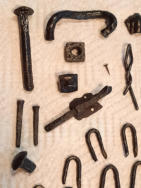






















September 7, 2023 - River Lots 155 and 154
September 7, 2023
River Lots 155 and 154.
River
Lots
#
155
and
154…
Today
I
expanded
my
search
a
bit
further
southwards,
looking
for
the
old
Pembina
Trail.
The
branching
off
of
the
Trail
goes
from
three
branches
down
to
two.
At
some
point
in
time
I
will
try
detecting
strictly
on
the
north
south
ridges
running
along
these
river
lots.
During
wet
or
during
flooded
periods,
that’s
where
the
travelling
would
have
occurred.
At
the
moment,
I
am
trying
to
gauge
where
exactly
the
trail
might
be.
I
have
a
copy
of
the
1870
survey
and
I
have
tried
as
best
as
I
could
to
superimpose
it
over
a
Google
map.
I
have
a
good
idea
as
to
where
it
lays
but
detecting
actual
period
finds
would
confirm
my
ideas and be the cat’s meow as well.
At
this
point
in
time,
I
am
metal
detecting
in
an
organized
fashion
moving
from
East
to
west
and
returning.
This
is
how
I
found
the
boat
oar
anchor
back
in
May.
See:
May
28,
2023
Following
the
Pembina Trail.
The
hunt
today
has
yielded
what
I
believe
to
be
period
artifacts.
However
small
they
may
be,
I
found
6
thick
cast
iron
pieces
that
quite
possibly
were
part
of
a
cooking
pot
or
vessel
of
sorts.
They
are
old
iron,
slightly
curved
and
were
all
found
within
close
proximity of each other.
Here
is
a
metal
detecting
tip
that
I
picked
up
watching
YouTube
videos.
When
something
good
is
found,
while
working
a
grid
or
moving
in
a
given
direction,
break
from
the
grid
for
a
moment
and
detect
in
an
ever
growing
spiral
around
the
location
of
the
find.
It’s
a
quick
way
of
finding
more
pieces
that
might
belong
to
or
with
the
initial
find.
This
is
what
I
did
here
and
it
proved
to
be
a
valuable
tip.
I
have
also
taken
to
marking
my
finds
with
flags,
especially
at
this
location.
It
is
a
great
indicator,
when
one
looks
back,
as
to
where
most
of
the
finds
are
and
at
times
reveals
patterns
that
might
be
otherwise
missed.
I
don’t
use
flags
on
beaches
or
public
parks
and
school yards but here, in an open field, it’s a great tool to use.
So
there
are
the
6
thick
cast
iron
bits
that
are
old.
Then
there
is
the
C
clamp
looking
piece
that
possibly
was
part
of
a
working
horse
bridle
or
hitch
system.
The
6
inch
long,
dinosaur
horn
looking
thing
is
actually
a
part
of
the
business
end
of
a
swather.
The
triangular
cutter
teeth
would
have
slid
back
and
forth
along
the
open
separation.
I
had
some
help
detecting
today
when
my
brother
Geatan
came
over
for
a
visit.
Just
in
time
to
help
me
dig.
We
used
my
big
shovel
to
get
this
out.
This
find,
a
long
bent
steel
bar
was
buried,
lying
flat,
at
over
a
foot
deep
in
the
ground.
Geatan
was
the
one
to
recognize
its
use…
it’s
a
socket
wrench.
Notice
the
square
nub
at
the
lower
end.
It
must
have
taken
an
incredible
amount
of
torque
to
bend
this
piece.
I
don’t
imagine
the
socket
itself
would
have survived but that we did not find.
Not
all
targets
and
subsequent
digs
turn
out
to
be
historic….
Beer
cans anyone?
The
two
top
rocks
are
both
fossils
of
shells.
Very
nice
but
difficult
to
spot.
The
last
picture
is
some
of
the
finds
once
cleaned
up,
processed
and oiled.
Roger









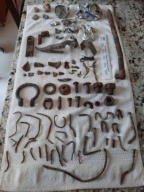









September 10, 2023 - Site of the old Tache School. 1914.
September 10, 2023
Site of the old Tache School.1914.
My
good
friend
and
high
school
buddy
Marc,
who
by
coincidence,
is
a
retired
school
teacher,
was
quite
keen
on
metal
detecting
with
me
at
this;
the
site
of
an
old
rural
school.
The
school,
called
Tache
School,
was
built
in
1914.
It
would
be
replaced
by
a
newer
school,
also
called
Tache
School
built
in
1952.
The
1914
school
was
built
on
the
South
East
corner
of
Section
#
4
-3
-1E,
three
miles
north
of
the
village
of
St.
Joseph.
The
replacement
school
was
built
on
the
North
East
corner
of
the
same
section.
We
detected
the
site
of
the
1914
school.
After
a
good
number
of
phone
calls
and
ownership
inquiries,
I
was
able
to
obtain
“Permission
to
Metal
Detect”
from
the
owner.
To
him,
Marc and I say thank you!!!
We
arrived
early
on
site
on
what
was
a
beautiful
Sunday
morning.
There’s
not
much
there
to
be
seen.
Nothing
that
would
belie
a
former
school
site
other
than
a
few
pieces
of
concrete
and
what
seemed
to
be
an
unusually
flat
area.
It
was
a
now
harvested
wheat
field.
Every
metal
detecting
site
has
its
unique
characteristics
and
as
I
like
to
say
“Flavor”.
It
took
quite
a
while
for
the
both
of
us
to
get
our
groove
and
understand
the
site.
Remember,
there’s
nothing
on
the
surface
that
indicates
where
the
school
was,
plus
there
is
a
layer
of
wheat
stubble
hiding things.
The
first
find
of
the
day
was
a
round
axle
cover.
Yes,
it’s
a
farm
machine
part.
We
are
in
farm
country.
I
think
we
found
more
machine
parts
than
school
related
items.
In
fact,
by
the
end
of
the
day,
I
was
quite
dismayed
at
the
lack
of
school
items.
No
coins,
no
buttons,
no
religious
medallions,
no
metal
pencil
ends,
etc.
But….
What
an
interesting haul nonetheless !!!
Of
note
were
the
many
pieces
of
what
I
call
Big
Iron.
The
part
plate
with
the
circular
writing
might
have
been
the
front
door
of
a
coal
furnace.
We
had
to
dig
deep
for
many
of
these:
6
inches
to
at
times
1
foot
deep.
I
think
that
soil
might
have
been
brought
in
to
cover
the
remnants
of
the
school’s
foundations
and
foot
print,
hence
the
deep
big
iron.
It’s
just
odd.
1
school
bench
leg
was
recovered
along
with
a
few "Klinkers" and coal for heating too.
Also
found
was
a
homemade
cutter
or
knife
using
the
triangular
tooth
from
a
swather
cutter
bar.
My
dad
had
one
too.
It
was
used
to
cut
the
twine on hay bales when feeding cattle.
In
all,
3
spoons
were
found,
Ok…
2
spoon
bowls
and
one
well
bent
silver
plated
spoon
marked
WMA
Rogers.
Also
inserting
is
a
small
piece
of
what
I
believe
might
be
Uranium
Glass.
It’s
the
yellow
piece.
The
vintage
shotgun
shell
has
a
cardboard
core.
Its
marked:
ELEY
No. 12 LONDON
Notice the rolled sardine or ham can top?
The
fun
part
of
today
was
our
visitors.
My
brother
Michel
dropped
by
as
did
the
neighbor’s
cat,
twice,
and
I
had
not
seen
this
type
of
caterpillar since I was a kid on our family farm.
All in a day when out metal detecting!
Roger
Reference:
https://antiquesilver.org/how-to-identify-a-wm-rogers-
silver-plate-history-of-william-rogers/
h
t
t
p
s
:
/
/
w
w
w
.
d
e
c
o
r
a
t
i
v
e
c
o
l
l
e
c
t
i
v
e
.
c
o
m
/
b
l
o
g
/
a
-
b
e
g
i
n
n
e
r
s
-
g
u
i
d
e
-
t
o
-
uranium-glass
h
t
t
p
s
:
/
/
a
u
s
s
i
e
m
e
t
a
l
d
e
t
e
c
t
i
n
g
.
c
o
m
/
s
h
o
t
s
h
e
l
l
-
r
e
s
o
u
r
c
e
s
/
s
h
o
t
s
h
e
l
l
-
headstamp-database/eley-headstamps/








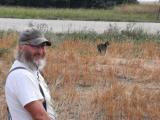











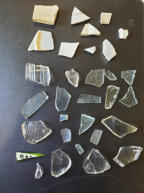








September 19, 2023 - Expect the Unexpected. River Lot 152.
September 19, 2023
Expect the Unexpected. River Lot 152.
River
Lot
#
152
proved
to
be
quite
the
surprise
and
I
have
a
feeling
that
it
will
continue
to
surprise
us
for
some
time
to
come.
I
dug
up
16
lbs.
of
iron,
all
found
in
a
150
X
150
foot
area.
Big
iron;
old
iron;
big
and
old
iron
too.
All
mixed
in
with
the
most
delicate
copper
buttons
and a partial medallion dated 1830. Wow…
Need
I
go
on?
Oh
but
I
will…
Glass,
ceramic,
and
even
a
partial
tooth? Deer tooth that is.
In
fact,
there
was
so
much
big
iron
that
I
took
two
separate
“Overall”
photos of the finds.
Areas
for
detecting
need
not
look
like
much
at
surface
level.
Beauty
is
only
skin
deep,
remember?
Plain
and
boring
looking
can
yield
all
sorts
of
treasures.
It
really
all
boils
down
to
location,
location,
location,
and
by
that
I
mean
in
a
historical
context.
Archeologists
will
tell
you
that
people
would
settle
where
they
had
ready
access
to
water
and
be
near
a
travel
route
and
also
they
looked
for
elevation
points
to
see
game
from
afar.
Well
you
can
discount
the
elevation
idea
in
this
portion
of
the
Red
River
Valley
unless
you
want
to
count
in
the
view
from
the
top
of
the
river
bank.
The
Red
River
was
the
highway
and
the
Pembina
Trail
was
right
there
for
one
to
use
as
well.
Both
run
parallel
to each other in a North - South direction.
Hence,
I
have
found
quite
a
few
spots
where
early
settler
or
human
habitation became evident.
See:
October
22,
2022
Monty,
Myself,
and
the
triangle
field
of
River
lot
#
159.
The
little
triangle
that
could.
AND:
October
19,
2022
How
About
those Bells… and a Wheat Pattern.
The
east
end
of
River
Lot
152,
sits
right
up
against
the
Old
14
and
fits
the
bill
for
early
settlement.
I’m
inclined
to
believe
that
some
of
the
pieces
found
predate
the
1870
Survey
as
nothing
on
the
survey
is
shown on that river lot but open prairie.
Some
of
the
finds
clearly
came
later
and
are
from
various
agricultural
eras.
Other
items,
like
the
molten
lead…
who
knows
how
and
when
that happened.
The highlights of this outing are as follows:
16 lbs of iron.
1 – Pipe Wrench.
1 – Partial Religious Medallion dated 1830.
3 - Pieces of coloured ceramic pottery.
3 – Pieces of pottery with discernible patterns.
1 - Partial Table Knife (iron).
4 – Partial Buttons or Fasteners.
1 – Door Hinge.
3 – Conveyor Chain Links.
4 – Railway Spikes
Multiple Pieces of shaped cast iron, some with patterns.
1- Partial Deer Tooth and a small piece of bone.
2- Small pieces of Coal.
4 – Pieces of Molten Lead.
An array of colored glass and ceramics.
Round and Square Nails.
Small Copper and Aluminium pieces of unknown usage.
Overall, quite the day.
Enjoy…
Roger
























September 27, 2023 - Gimli Beach gives up its gold!
September 27, 2023
Gimli Beach gives up its gold!
A
great
day
indeed.
This
is
the
only
beach
metal
detecting
outing
that
I’ve
done
this
year.
In
reality,
I
Metal
Detected
on
two
beaches.
The
first
portion
of
this
post
shows
a
shore
line
and
beach
that
is
mostly
submerged
due
to
high
easterly
winds
and
the
finds
from
this
location.
The
location
is
directly
south
of
the
Gimli
Viking
Statue.
Under
normal
weather
conditions,
the
sand
is
accessible
at
least
3
blocks
south
from
here.
The
finds
here
were
very
trashy
but
quite
telling
of
the
power
of
nature
over
time
on
things
like
pop
cans.
Notice
the
amount
of
tops
or
bottoms
found
where
the
sides
have
been
ground
down
to
its
micro-elements.
Some
of
the
cans
look
like
they exploded. Even glass gets worn right down.
The
scenery
over
Lake
Winnipeg
is
breathtaking.
Today
was
no
exception. The 5th picture shows the first beach that I detected on.
The
second
half
of
my
day
on
Gimli
Beach
proper,
proved
to
be
quite
as
exciting
and
as
thrilling
as
metal
detecting
gets.
I
walked
away
with
the
prize
of
the
year:
A
ladies
10K
gold
ring
adorned
by
a
gorgeous
onyx
stone.
Gimli’s
beaches
are
almost
deserted
at
this
time
of
year.
Gone
are
the
crowds
of
sunbathers
and
families
and
kids,
and
swimmers.
I
had
a
go
of
it,
all
by
myself.
This
little
treasure
was
found
right
at
the
water’s
edge
at
about
4
inches
deep.
An
easy
find
really.
Also
quite
perplexing
was
this
Samsung
Cell
Phone.
It
had
to
have
been
buried
purposefully
as
I
had
to
use
my
big
shovel
to
get
it
out.
It
was
at
least
10
inches
deep,
below
the
water
table,
and
standing
upright.
Somebody
must
have
been
really
mad
at
someone
or
the
phone
contained
incriminating
evidence
of
some
sort. Hey… What happens in Gimli sometimes stays in Gimli.
Also
of
interest
is
what’s
left
of
a
fork
or
spoon,
flatware
and
the
ever
present
.22
shell
casings.
I
seem
to
find
these
on
every
beach
I’ve
been
to.
I’m
curious
to
know
how
these
molten
lead
blobs
found
their
way
onto
the
beach.
Where
do
they
originate
from
or
what
were
they
a
part
of,
I
have
no
idea.
Pull
tabs
are
always
a
pain…
But
they
ring
up
on
most
metal
detectors,
the
same
as
rings,
jewelry
rings.
You
just
can’t
not
dig
them
up
or
you
risk
missing
a
great
find
like
a
ladies
10K
gold
ring.
To
be
fair,
the
old
style
beaver
tail
pull
tabs
are
exactly
that: a ring.
The
fossils
are
easy
to
spot
and
one
always
ends
up
with
a
pocket
full of colorful rocks.
Roger
References:
http://www.mhs.mb.ca/docs/sites/vikingstatue.shtml
https://interlaketourism.com/beaches_lakes_parks/gimli-beach-park/
https://en.wikipedia.org/wiki/Onyx
https://www.gemsociety.org/article/black-onyx-jewelry-and-gemstone-
information/
https://en.wikipedia.org/wiki/Lake_Winnipeg

September 30, 2023 - The line between Sec 36 NE and River Lots 149 – 152.
September 30, 2023
The line between Sec 36 NE and River Lots 149 – 152.
It
was
my
nephew’s
idea.
A
power
line
had
just
been
removed
from
in-between
two
farm
fields.
This
power
line
had
stood
there
forever
and
a
day;
long
before
I
ever
played,
walked
around,
and
explored
this
area
as
a
child.
Some
time
ago,
Gabriel,
my
nephew
said
“They
just
removed
the
power
line
and
posts.
I
wonder
what’s
all
been
left
behind between those fields. You should go and Metal Detect it”
Not
a
bad
idea
but
not
something
I
would
have
prioritized
as
such.
So
I
thought
about
it
and
kept
it
in
the
back
of
my
mind.
It’s
the
end
of
September
now
and
there’s
about
one
month
left
of
good
metal
detecting
to
be
had.
The
fields
that
I
still
want
to
access
this
year
still
have
crops
on
them
and
I
was
looking
for
something
new
or
different
to
do.
I
also
wanted
to
bring
the
dogs
out
with
me
for
a
good
run
around
but
it
had
to
be
somewhere
where
sticky
weeds
like
Beggar’s
Lice
(Hackelia
virginiana)
or
Common
Cocklebur
(Xanthium
strumarium) would not be a problem.
Hey…. The old power line idea just happened to fit the bill.
I
got
there
early.
It’s
right
across
the
road
from
the
family
farm.
The
moon
hanging
over
the
farmyard
made
for
an
interesting
photo.
This
is
where
the
Red
River
Lots
152
down
to
149
butts
up
against
Sec
36
NE.
It’s
a
half
mile
walk
south
to
where
NE
becomes
SE.
The
dogs
were
safe
from
nasty
sticky
weeds
but
the
heavy
morning
dew
made
a
mess
of
them.
Harmless
yes,
but
it
was
shower
time
for
all
of
us
when we got home.
The
finds
were
interesting
enough
but
sorry,
no
buried
cache
of
coins
were
found.
I
knew
that
I’d
find
a
few
fencing
staples
(14
in
total),
as
almost
all
the
fields
were
fenced
in
at
some
point
in
their
history.
What
particularly
struck
me
was
the
height
of
soil
mounds
around
where
the
hydro
poles
had
stood.
It’s
difficult
and
risky
to
work
the
land
surrounding
hydro
poles
so
the
drifting
soil
gets
caught
by
the
prairie
grasses
and
the
ground
builds
up
and
up
and
over
time
you
end
up
with
a
small
mound.
The
land
was
also
separated
by
a
drainage
canal.
My
finds
were
almost
all
near
or
at
the
field’s
edge.
None at the very bottom of the ditch.
The
big
round
“Thing”
with
a
star
in
the
middle,
weighed
in
at
5
lbs.
Yes,
“Thing”…
Sprocket…
Whatever…
I
have
no
idea
what
that
is
other
than
it
was
undoubtedly
part
of
a
farm
machine.
How
that
got
separated
and
lost
from
the
remainder
of
the
machine
would
be
pure
speculation
and
would
make
for
a
funny
story
although
not
at
that
time
for
that
farmer
I’m
sure.
The
partial
wrench
is
geometrically
interesting.
I
do
enjoy
the
hand
wrung
barb
wire
piece.
And
well,
the
golf ball is anyone’s guess. Gabriel ???
The
flatware,
in
two
pieces,
were
found
together.
It’s
either
a
spoon
or
a
fork.
Judging
by
the
amount
of
rust
and
by
the
overall
look,
I
would
speculate
that
this
artifact
may
well
date
back
to
early
pioneer
days
or
may
even
have
belonged
to
one
of
the
surveyors
for
the
1870
survey.
This
is
exactly
where
they
worked.
The
block
of
concrete
once
held
a
survey
marker.
Years
of
farm
equipment
rolling
over
it
has
removed
the
brass
marker
disc
a
long
time
ago.
It
would
be exciting to find that piece out in the field somewhere.
So
to
my
nephew
I
say:
“There!
This
is
what’s
all
been
left
behind
between those fields”.
The dogs and I enjoyed our day.
Roger
References:
https://www.picturethisai.com/wiki/Hackelia_virginiana.html
https://ipm.ucanr.edu/PMG/WEEDS/common_cocklebur.html
https://www.smallfarmcanada.ca/features/surveying-boundary-lines-
this-be-yours-and-this-be-mine-but-/
https://static1.squarespace.com/static/6148b130f68d7f1bb745938c/t/
6185ab073b28f4218e2ed168/1636150031489/Understanding+_DL_
Survey_System.pdf






































